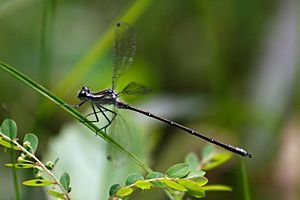Megapodagrionidae facts for kids
Quick facts for kids Megapodagrionidae |
|
|---|---|
 |
|
| Common flatwing (Austroargiolestes icteromelas: Argiolestinae) |
|
| Scientific classification |
|
| Kingdom: | Animalia |
| Phylum: | Arthropoda |
| Class: | Insecta |
| Order: | Odonata |
| Suborder: | Zygoptera |
| Superfamily: | Calopterygoidea |
| Family: | Megapodagrionidae Calvert, 1913 |
| Genera | |
|
3+ |
|
The Megapodagrionidae are a family of damselflies. They are often called flatwings because of how they rest. When they are not flying, they spread their hind wings out flat, almost like an airplane. These damselflies belong to a larger group called the Calopterygoidea.
Contents
What are Flatwings?
Flatwings are a type of damselfly. Damselflies are insects that look a lot like dragonflies. However, damselflies are usually smaller and more slender. When they rest, most damselflies hold their wings together over their back. Flatwings are special because they hold their wings out flat. This unique resting position helps them blend in with their surroundings.
Where Do Flatwings Live?
Flatwings are found in different parts of the world. Many species live in Australia and other tropical areas. They usually live near water, like streams, rivers, or ponds. This is because damselfly young, called nymphs, live in the water.
What Do Flatwings Eat?
Adult flatwings are predators. They hunt and eat smaller insects. They are very good at catching their prey while flying. Their diet helps control insect populations in their habitats.
How Flatwings Are Grouped
Scientists group living things into families to understand them better. The Megapodagrionidae family is usually divided into smaller groups called subfamilies. There are typically five or six of these subfamilies.
- Argiolestinae
- Hypolestinae
- Megapodagrioninae
- Philosininae
- Pseudolestinae
The Argiolestinae group has the most types of flatwings. Other groups, like the Megapodagrioninae, have fewer species. Sometimes, the Pseudolestinae are even considered their own separate family.
New Discoveries in Classification
Scientists are always learning new things about how living things are related. In 2013, a study looked closely at the Megapodagrionidae family. This study suggested that the family might be smaller than once thought. It proposed that only three main groups, or genera, truly belong to this family:
- Allopodagrion
- Megapodagrion
- Teinopodagrion
This shows that the way scientists classify animals can change as they gather more information.
See also
 In Spanish: Megapodagrionidae para niños
In Spanish: Megapodagrionidae para niños

